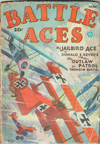“Richthofen’s Last Flight” by Frederick Blakeslee
Editor’s Note: This month’s cover is the tenth of the actual war-combat pictures which Mr. Blakeslee, well-known artist and authority on aircraft, is painting exclusively for BATTLE ACES. The series was started In give our readers authentic pictures of war planes in color. It also enables you to follow famous airmen on many of their amazing adventures and feel the same thrills of battle they felt. Be sure to save these covers if you want your collection of this fine series to be complete.
 THE COVER painting this month depicts the essential elements that combined to cause the death of Baron von Richthofen. All of the planes involved are shown.
THE COVER painting this month depicts the essential elements that combined to cause the death of Baron von Richthofen. All of the planes involved are shown.
Baron von Richthofen was the greatest ace Germany ever produced. He was a cool daring fighter who fought to kill or be killed, and the more skillful his adversaries were the better he liked them. To match wits with a clever opponent brought him the utmost pleasure. He fought like a demon, quickly and surely, taking advantage of every fortune of combat. His
deadly aim accounted for the crashing of eighty Allied planes.
An analysis of his combats show that of his eighty victories, forty-six of the vanquished were two seaters and thirty-four were single-seater scouts. He killed eighty-eight men in these combats, seventeen of whom were unidentified. His record of eighty may be disputed, however, for there are no British casualty records to account for three of the ships which were reported by von Richthofen. If we give him the benefit of the doubt—and there is no evidence that he did not bring down these three—eighty is an imposing” record. He was the terror of the Front and in his all-red ship he blazed his way through the sky from September 17, 1916, until the day of his death, April 21, 1918.
Von Richthofen’s circus became a byword at the Front. The ships composing this staffel resembled a sinister rainbow. They were painted in every color imaginable, no two ships being alike and every one having a different combination. Only one of his circus had a single color scheme. This ship—a Fokker triplane—painted a brilliant red except for the black maltese cross on its white background.
It fell to the lot of Captain Roy Brown to put an end to “The Red Knight of Germany. This he accomplished on April 21, 1918, in the vicinity of Hamel. Four triplanes led by von Richthofen had dived on some old R.E.’s which were engaged on a photographic mission. Captain Roy Brown, with his flight of seven Camels, was two miles above. His attention was directed to the plight of the R.E.’s by the English anti-aircraft calling for help. Down he came in a two-mile dive with his flight screaming in his wake.
The triplanes had been joined by additional Fokkers and Albatrosses, so that they numbered about twenty-two. With guns blazing, the eight Camels plunged into the fight. It developed into one of the most desperate dogfights of the War.
The R.E.’s relieved of their pursuers, streaked for home and escaped.
In Captain Brown’s flight was Lieut. W.R. May, a newcomer and out for the first time. Nevertheless he joined the melee. After downing a Boche he remembered his orders to stay out of a combat, so with great difficulty he disengaged himself and started for home. Death, however, in the form of an all-red triplane, rode on his tail. Do what he could, side, slip, loop and turn, May could not shake the cool and determined fighter who pursued him. His ship was being-shot to pieces and he was painfully wounded. But fortunately death showed no partiality and also road on the tail of the red triplane. Brown had seen the unequal combat and diving in from the right his tracers tucked a seam up the body of the Fokker until they reached the cockpit. The triplane faultered, then glided to the earth, making a nearly perfect landing. It settled between the lines. The pilot did not move. An Australian crawled over the top, attached a rope to the undcr-carriage and drew it to the shelter of a rise in the ground. The pilot was taken out. Baron von Richthofen was dead.

The triplane was another creation of Anthony Fokker, It was speedy and a machine to be avoided in a scrap. Some authorities contend that it had one fatal fault—its tendency to tear itself apart in the air. For this reason the Germans finally abandoned it.
The Fokker triplane had a 110 h.p. engine and its speed was approximately 125 m.p.h. It was 19 feet, 1 inch in length over all and had a top wing span of 25 feet including the balancing fins on the aileron. The span of the center wing was 21 feet and that of the bottom wing was 19 feet. It carried two fixed machine guns on the cowl, syncronized through the propeller.

“Richthofen’s Last Flight” by Frederick M. Blakeslee (March 1932)





